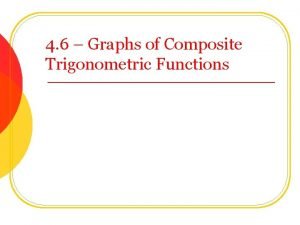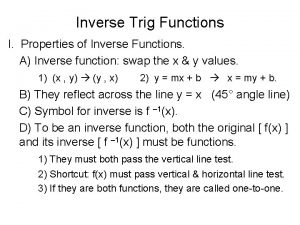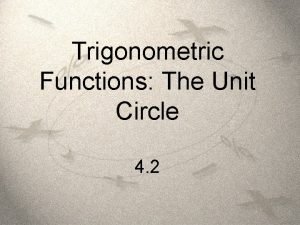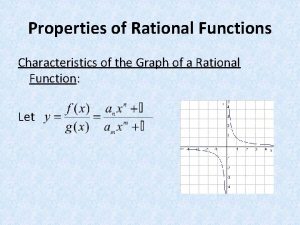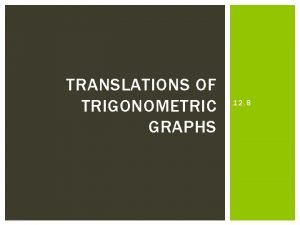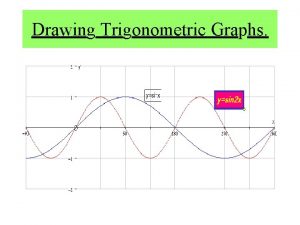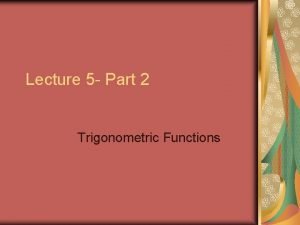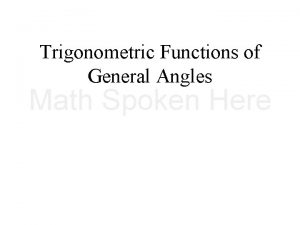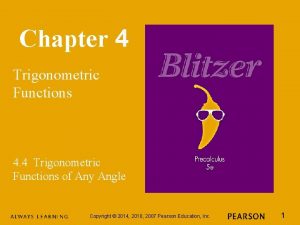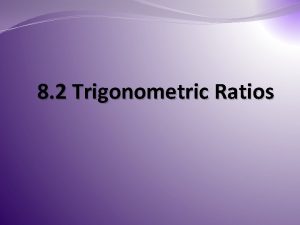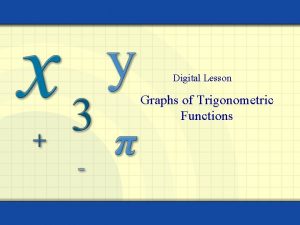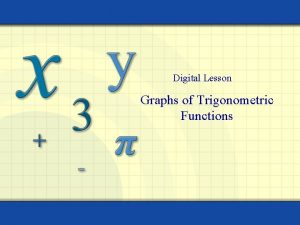The Graphs of Trigonometric Functions 1 Properties of













- Slides: 13

The Graphs of Trigonometric Functions 1

Properties of Sine and Cosine Functions The graphs of y = sin x and y = cos x have similar properties: 1. The domain is the set of real numbers. 2. The range is the set of y values such that . 3. The maximum value is 1 and the minimum value is – 1. 4. The graph is a smooth curve. 5. Each function cycles through all the values of the range over an x-interval of. 6. The cycle repeats itself indefinitely in both directions of the x-axis. 2

Graph of the Sine Function To sketch the graph of y = asinb x, assign values of x (angle measures in π radians) and y is the sine of your angle x. First locate the key points. These are the maximum points, the minimum points, and the intercepts. Based on the graph, he maximum point is the value of a. The minimum point is the negative of a. x 0 sin x 0 1 y 0 -1 0 y = sin x x 3

Graph of the Cosine Function To sketch the graph of y = cos x first locate the key points. These are the maximum points, the minimum points, and the intercepts. x 0 cos x 1 0 -1 0 1 Then, connect the points on the graph with a smooth curve that extends in both directions beyond the five points. A single cycle is called a period (red portion of the graph). y = cos x y x 4

Example: Sketch the graph of y = 3 cos x on the interval [0 , 2 ]. (Assign values of x (angle measures in π radians) and y is the sine of your angle x). x 0 y = 3 cos x 3 max (0, 3) y 0 -3 0 3 x-int min x-int max 2 ( , 3) x ( ( , 0) ( , – 3) 5

AMPLITUDE OF A TRIGONOMETRIC GRAPH The amplitude of y = a sin x (or y = a cos x) is half the distance between the maximum and minimum values of the function. The max. value of the graph is 1 and the min. value is -1. Therefore the amplitude is, a = |(max - min)/ 2| = |(1 - (-1))/ 2| a=1 amplitude = |a| y x y = sin x 6

The amplitude of y = a sin x (or y = a cos x) is half the distance between the maximum and minimum values of the function. amplitude = |a| If |a| > 1, the amplitude stretches the graph vertically. y The max. value of the graph is 2 and the min. y = 2 sin x value is -2. Therefore the x amplitude is, a = |(max - min)/ 2| = |(2 - (-2))/ 2| a=2 7

If 0 < |a| > 1, the amplitude shrinks the graph vertically. y y= sin x The max. value of the graph is 0. 5 and the min. value is 0. 5. Therefore the amplitude is, x a = |(max - min)/ 2| = |(0. 5 - (-0. 5))/ 2| a = 0. 5 8

The period of a function is the x interval needed for the function to complete one cycle. A cycle is length of one pattern. period of y = For b = 1, the period of y = a sin bx is y . period: 2 x The period is 2π because the distance travelled by the curve to complete one cycle is 2π 9

If 0 < b < 1, the graph of the function is stretched horizontally. y period: 4 x The period is 4π because the distance travelled by the curve to complete one cycle is 4π 10

If b > 1, the graph of the function is shrunk horizontally. y x The period is π because the distance travelled by the curve to complete one cycle is π 11

Determine the Amplitude and Period of the Trigonometric Function. 1. y = sin x Since in the function y = asin bx and y = acos bx, the amplitude is a and the period is 2π / |b|, then: Amplitude = 1 Period = 2π / |1| = 2π 12

Determine the Amplitude and Period of the Trigonometric Function. 2. y = cos 2 x Amplitude = 1 Period = 2π / |2| = π 3. y = 3 sin 4 x Amplitude = 3 Period = 2π / |4| = π/2 13
 Graphs of composite trigonometric functions
Graphs of composite trigonometric functions 5-3 practice polynomial functions
5-3 practice polynomial functions Inverse sine chart
Inverse sine chart Unit circle4
Unit circle4 Properties of rational function
Properties of rational function Investigating graphs of polynomial functions
Investigating graphs of polynomial functions Investigating graphs of functions for their properties
Investigating graphs of functions for their properties 12-8 practice translations of trigonometric graphs
12-8 practice translations of trigonometric graphs Drawing trig graphs
Drawing trig graphs Lesson 14 graphing the tangent function
Lesson 14 graphing the tangent function Good state and bad state graphs
Good state and bad state graphs Comparing distance/time graphs to speed/time graphs
Comparing distance/time graphs to speed/time graphs Graphs that enlighten and graphs that deceive
Graphs that enlighten and graphs that deceive Maximum value of trigonometric functions
Maximum value of trigonometric functions
